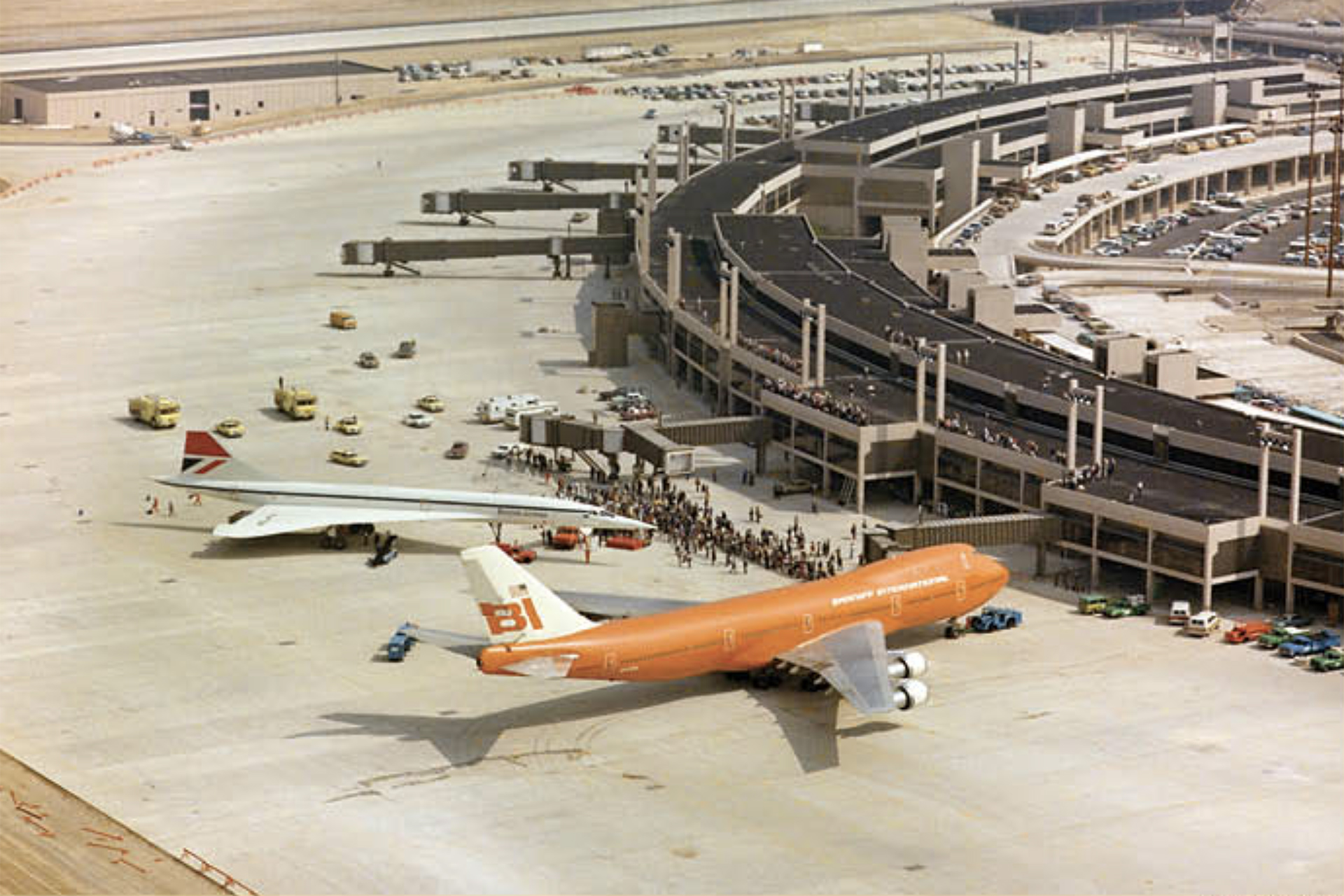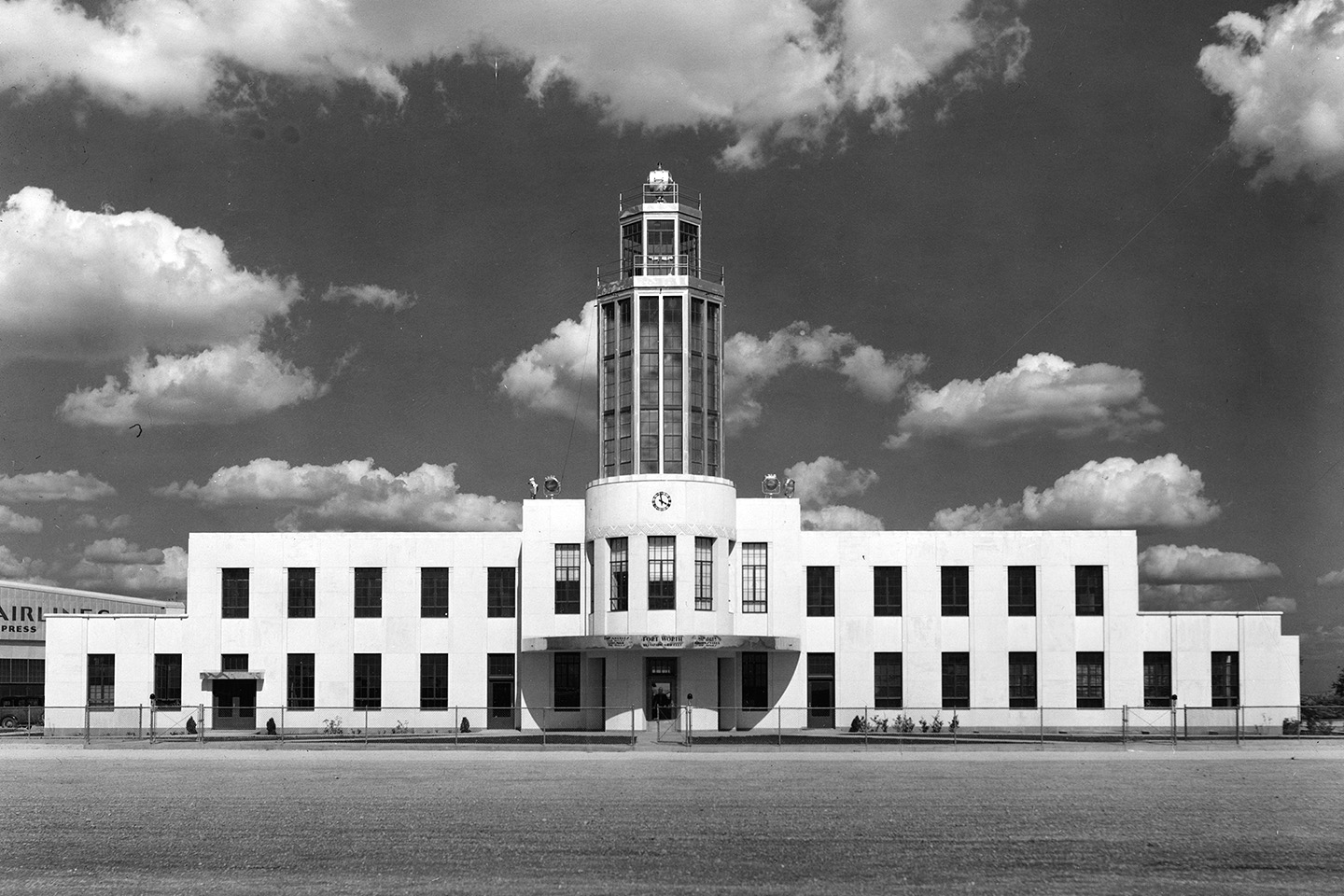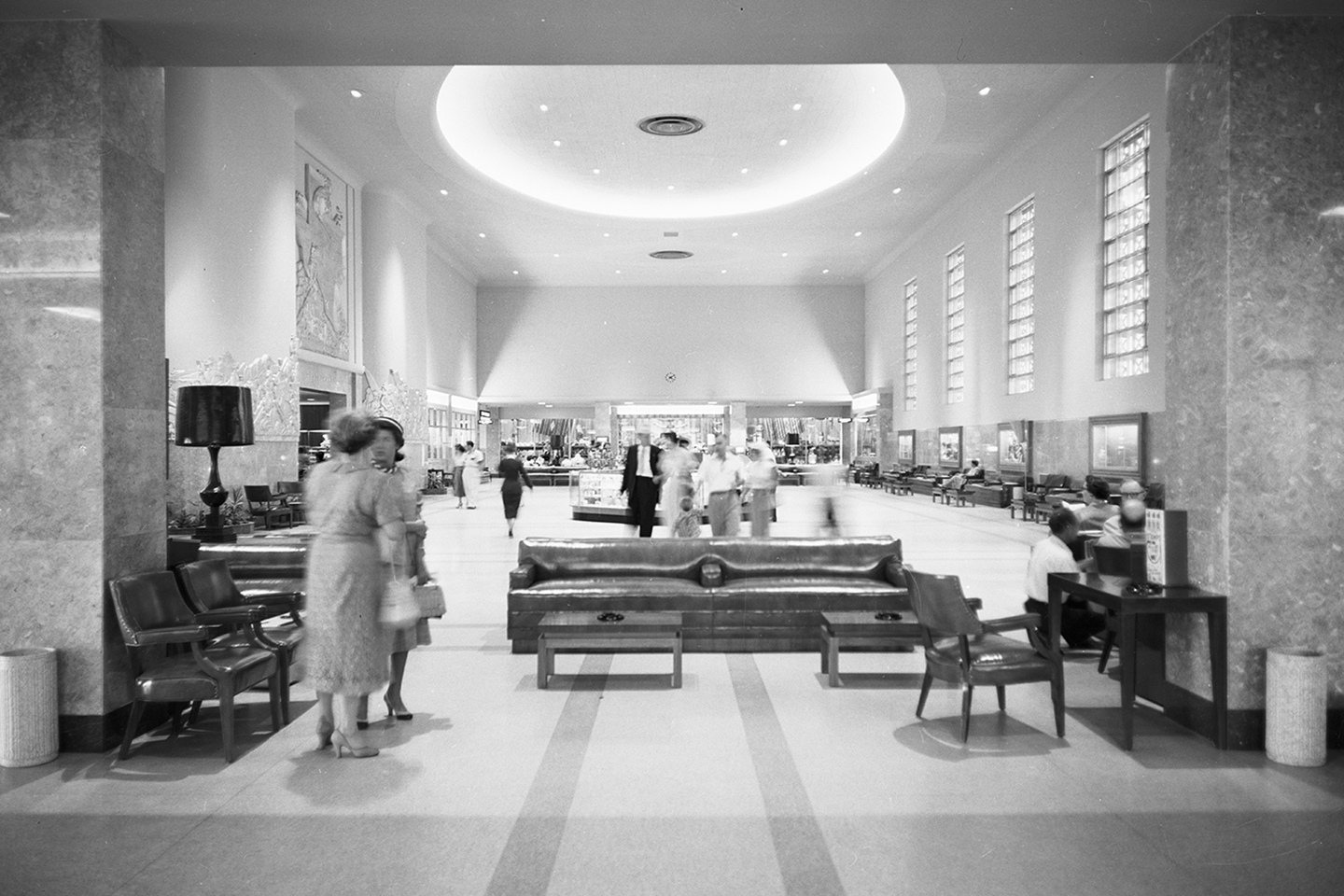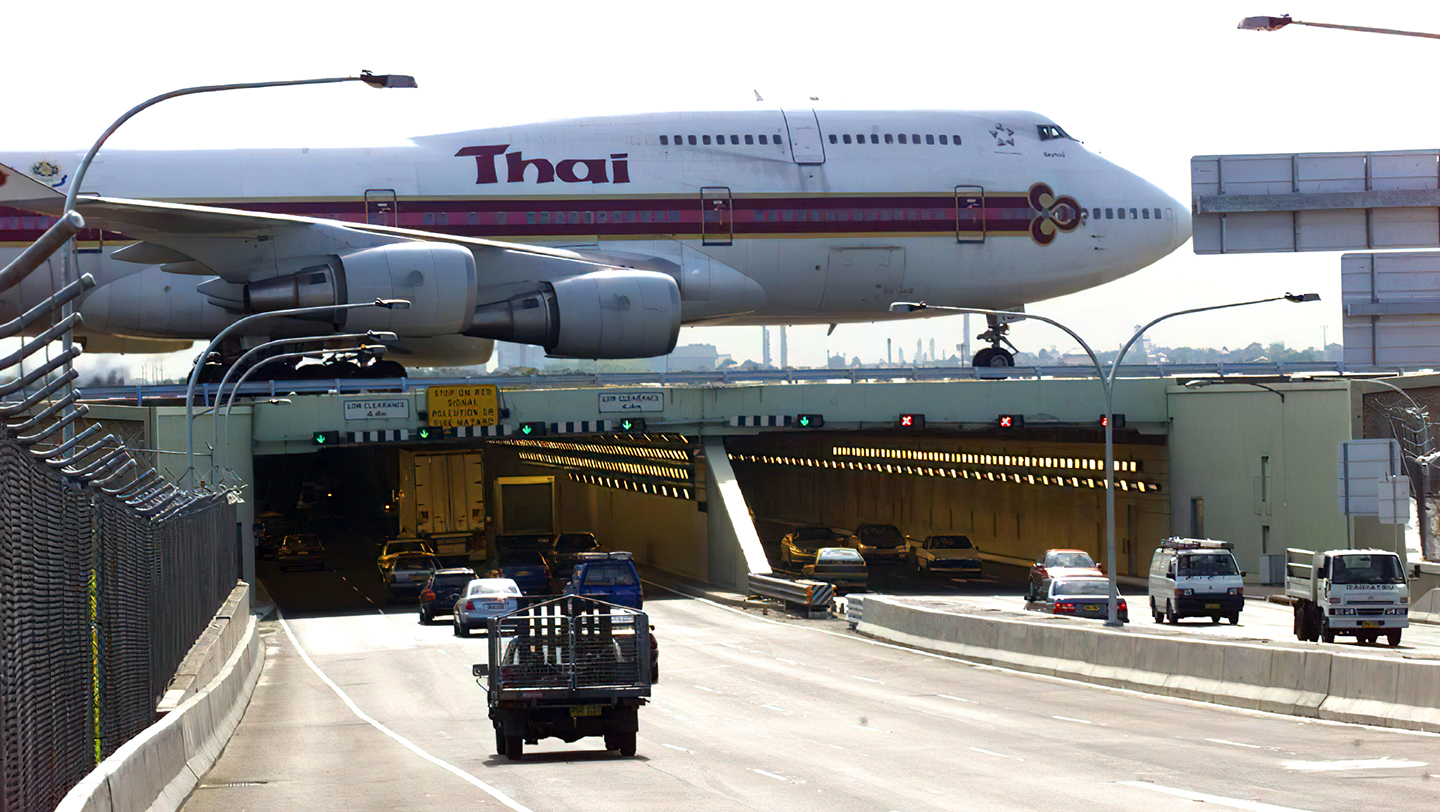
The Long Road to a Regional Airport for Dallas-Fort Worth
A special edition of the Arlington Citizen-Journal published in February 1972 contained an article entitled, "Ancient Idea Finally Materializes As Regional Airport Takes Shape." At the time of its publication, DFW International Airport was under construction. The Citizen-Journal article was based on events leading up to a regional airport for Dallas and Fort Worth, as outlined by George E. Burlage in a January 1969 master's thesis at North Texas State University (see the full citation at the end of this article). The primary purpose of Mr. Burlage's thesis was to explore the federal government's (as well as state and regional organization’s) expanding role in shaping the development of a regional airport for the area. In doing so, he provided much valuable history of discussions between Dallas and Fort Worth representatives, and the role of the city of Arlington. The following is from that Citizen-Journal article plus the insertion of some additional material from Burlage's 1969 master's thesis. Finally, an update is provided explaining what happened to the Greater Southwest International Airport (GSW) in its latter years, and after the decision was made to start construction on the Dallas/Fort Worth International Airport.
Early Beginnings for Dallas and Fort Worth Commercial Aviation
A regional airport for Dallas and Fort Worth was an idea that had been knocking around since 1927. There were several "false starts" that led to the eventual DFW Airport.
Fort Worth got an early start in commercial aviation when, in 1926, the City took over an old Army Field and made it into a municipal airport, which, in 1927, they named Meacham Field (after the Mayor who had urged its creation). About that same time, Dallas approached Fort Worth with the idea of a regional airport, but Fort Worth rejected the proposal. As a result, Dallas entered commercial aviation by purchasing (in 1927) the Army airport, Love Field (which had been named by the Army in 1917 in honor of an Army officer killed when his airplane crashed in San Diego in 1913).

The CAA and Braniff and American Airlines Enter the Picture
Both Meacham and Love Field airports were expanded and improved in the 1930s, but as larger aircraft such as the four-engine airliners were brought into operation, more expensive improvements were necessary and the airlines became reluctant to operate from two fields as close together as Dallas’ and Fort Worth’s airports.
From this economic dilemma came the first federal government steps toward a regional airport. At this time, movers of such an airport were not the cities, but the Civil Aeronautics Administration (CAA) and two major airlines, Braniff and American, which both served both Meacham and Love Field. The CAA became interested because of requests for aid made by both cities under a program of federal aid for airport construction. The question was raised by the CAA (in September 1940) as to whether the needs of the area could not best be served by a single airport for the two cities.
In the meantime, a new statewide committee, known as the Texas Aeronautics Advisory Committee, was meeting in Wichita Falls to develop priorities for airports in Texas and to study the possibility of a joint airport for the two cities. Both cities agreed on the principle of a regional facility, but Dallas said the airport should be closer to Dallas because of its greater volume of business. Fort Worth representatives flatly refused, and an impasse developed. The CAA took on the role of arbiter, but to no avail.
The Army Calls for an Airport of its Own between Dallas and Fort Worth
About this time, the CAA office in Washington reported that the Army was interested in an airport located between the two cities. In the background were Braniff and American, who had originally suggested the one-airport concept. When no results were forthcoming for the CAA after numerous attempts with the two cities, in 1941 the CAA officials turned to Arlington, the mid-point community of 4,000 population between the two cities. Braniff and American entered the negotiations and agreed to purchase acreage for an airport mid-way between Dallas and Fort Worth, deed the acreage to Arlington, and execute lease agreements to operate and maintain the completed airport. The CAA promptly recognized Arlington's position and allocated money for construction of an airport. The airport was to be named "Midway Airport, Arlington, Texas." Dallas strongly contended that sponsorship of the airport should be limited to the cities of Dallas and Fort Worth, and urged Arlington to withdraw. However, Texas law at that time implied that joint sponsorship/ownership of an airport was not legal (after the war, this matter was resolved, permitting joint sponsorship and ownership).
Where was the site chosen for this Midway Airport that was to be used by the Army during WW II? There is a website created by Paul Freeman, "Abandoned & Little-Known Airfields." This website covers 2,300+ former airports across the nation. The portion of the site dealing with the lead-up to the DFW airport is http://www.airfields-freeman.com/TX/Airfields_TX_FtWorth_NE.htm. One contributor to the Freeman website noted that "the earliest depiction of this field that has been located was a 10/15/43 aerial view from a 1945 AAF Airfield Directory. It was depicted as "Arlington Municipal Airport (Midway Airport)." The coordinates given for this airfield place it exactly where, after WW II, Fort Worth's Greater Fort Worth International Airport, renamed Amon Carter Field, and later named Greater Southwest International Airport (GSW), would be located. The site is between what is now Highway 360 on the west and the Dallas/Tarrant county line on the east, and Highway 183 on the north and a railroad on the south.
A layout of the field and the building area was made. Buildings were to be on the west side of the airport to permit adequate expansion and the most economical layout of runways. Dallas Mayor Woodall Rodgers blasted the CAA, saying that Dallas was insulted because the back door of the planned administration building was facing toward Dallas. The matter was appealed to U.S. Secretary of Commerce, Jesse Jones. Jones said the terminal matter could be decided after the war but that the Army needed this Midway Airport during the war for training pilots. He asked Arlington to take over the operation. Construction was started May 24, 1942, and was completed and turned over to Arlington for operation in July 1943, and the airport continued in military use until the end of WW II, as a training field and for test flights.
Fort Worth Goes Ahead with its Own New Airport on the Old Army Site
A month before construction began on Midway Airport (for the Army's use during WW II), Dallas announced that it was ending negotiations on a regional airport and would concentrate on Love Field. After the War, in 1947, Fort Worth acquired the Midway Airport from Arlington. The city again attempted to get Dallas interested in a regional airport, but when this failed, Fort Worth went ahead with its plans to move its municipal airport from Meacham Field to the old Midway site. Meacham needed expansion, but was hemmed in by commercial development all around it. At this point, the Dallas City Council took an official stand that any attempt to remove their airline terminal from Love Field to the new Fort Worth airport "will be contested by Dallas with every means available."
In 1948, the CAA recommended that the old Midway airport be expanded into the area’s major regional airport. Dallas continued its opposition. However, talk of cooperation again appeared in early 1951. John W. Carpenter, president of the Dallas Chamber of Commerce, urged Dallas to join Fort Worth in the development of the old Midway Airport. He maintained that Love Field would be inadequate in five years and was improperly located to serve the area ten years from then. Carpenter's suggestion was met with "ridiculous" by Dallas Mayor Adoue, and the directors of the South and East Dallas Chamber of Commerce flatly opposed any Dallas participation in Midway. Carpenter's proposal died. Construction by Fort Worth of its new airport on the old Midway site continued.
Initially, Fort Worth was going to call its new airport on the old Midway site, "Greater Fort Worth International Airport," but at its dedication on April 25, 1953, changed the name to "Amon Carter Field" (ACF). In 1954, the Civil Aeronautics Board (CAB), in a letter to Fort Worth City Manager, W. O. Jones, suggested that a share of the new airport be sold to Dallas and the name changed, but further discussion did not materialize. In 1960, Fort Worth changed the name of the airport once again to "Greater Southwest International Airport" (GSW). The interior of the Terminal Building is shown in the photo below.

The Federal Government Orders Dallas and Fort Worth to "Get With It"
In 1964, the Federal Aviation Agency (FAA) (which had assumed the CAA's powers), tired of funding separate airports for Dallas and Fort Worth, announced that it would no longer support both. The two cities were ordered to come up with a plan for a regional airport.
In 1965, a Dallas/Fort Worth Regional Airport Board was organized as an interim body, and discussions began in earnest. A parcel of land (17,000 acres) north of the Greater Southwest International Airport was selected for a Dallas/Fort Worth Regional Airport. Early in the negotiations it was felt that a North Central Texas Regional Authority was needed to build and operate the facility. The Texas Legislature approved a constitutional amendment to allow the creation of such authorities and Texans passed it. However, voters in Dallas and Tarrant Counties were required to give their approval, but voters narrowly defeated the effort in Dallas County.
After the defeat, it was decided that under a 1947 State law, communities did have the authority to build airports together. In April 1968, the Airport Board was reconstituted as a permanent body. The Board was now ready to begin construction. The first spade of dirt on the new DFW Airport was turned December 12, 1968.
The long battle was a compilation of ironies, one of the biggest of which was summed up by Henry L. Newman, the Southwest Regional Director for the Federal Aviation Administration, who told a group in June 1967: “….the delay….is proving beneficial. If you attempted this airport ten or more years ago, it would now be outdated. You can now profit from the mistakes of others and build the world’s greatest airport.”
A Sad Ending for Fort Worth's GSW Airport
The old Greater Southwest International Airport (GSW) ceased service in 1969, as most carriers pulled out. From its opening, GSW had considerably less traffic than Love Field. In addition, Dallas launched a publicity campaign with travel agents promoting Love Field over GSW. The airport never reached capacity and saw its traffic dwindle while traffic at nearby Love Field in Dallas continued to grow. American Airlines was the last scheduled carrier at GSW. GSW remained operational as a training and maintenance facility for American, Braniff, and Delta. When the Dallas/Fort Worth International Airport opened in January 1974, the FAA closed the runways at Greater Southwest (GSW) as a safety precaution.
GSW was sold to a private real estate developer in 1979 for a commercial/light-industrial park. The attractive GSW terminal building was demolished in 1980 after being vacant for a decade. The last of the runways were removed by 1982. The north/south Runway #17 became Amon Carter Boulevard in the new development. A small section of the taxiway and run-up area of Runway #17 can still be seen at the northern end of Amon Carter Blvd., on the north side of State Highway 183. (In 1962, Runway #17 had been extended north across Highway 183, necessitating construction of a tunnel under the runway for Highway 183.) Today there is very little evidence that an attractive new airport ever existed there.

Credits:
Citation of the Burlage Master's Thesis: Burlage, George Edward. Federalism's Expanding Dimensions: a Case Study of Decision-Making of the Dallas-Fort Worth Regional Airport, thesis, January 1969; Denton, Texas. (https://digital.library.unt.edu/ark:/67531/metadc663335/: accessed August 17, 2018), University of North Texas Libraries, Digital Library, https://digital.library.unt.edu/.
